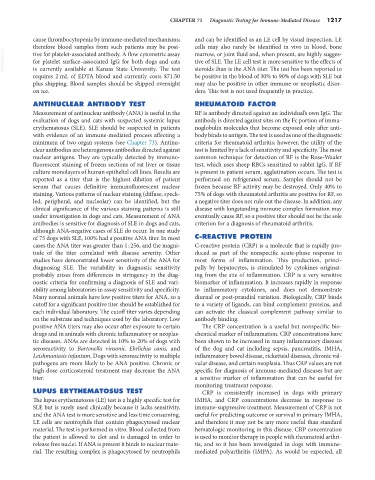Page 1245 - Small Animal Internal Medicine, 6th Edition
P. 1245
CHAPTER 71 Diagnostic Testing for Immune-Mediated Disease 1217
cause thrombocytopenia by immune-mediated mechanisms; and can be identified as an LE cell by visual inspection. LE
therefore blood samples from such patients may be posi- cells may also rarely be identified in vivo in blood, bone
VetBooks.ir tive for platelet-associated antibody. A flow cytometric assay marrow, or joint fluid and, when present, are highly sugges-
tive of SLE. The LE cell test is more sensitive to the effects of
for platelet surface–associated IgG for both dogs and cats
is currently available at Kansas State University. The test
be positive in the blood of 30% to 90% of dogs with SLE but
requires 2 mL of EDTA blood and currently costs $71.50 steroids than is the ANA titer. The test has been reported to
plus shipping. Blood samples should be shipped overnight may also be positive in other immune or neoplastic disor-
on ice. ders. This test is not used frequently in practice.
ANTINUCLEAR ANTIBODY TEST RHEUMATOID FACTOR
Measurement of antinuclear antibody (ANA) is useful in the RF is antibody directed against an individual’s own IgG. The
evaluation of dogs and cats with suspected systemic lupus antibody is directed against sites on the Fc portion of immu-
erythematosus (SLE). SLE should be suspected in patients noglobulin molecules that become exposed only after anti-
with evidence of an immune-mediated process affecting a body binds to antigen. The test is used as one of the diagnostic
minimum of two organ systems (see Chapter 73). Antinu- criteria for rheumatoid arthritis; however, the utility of the
clear antibodies are heterogenous antibodies directed against test is limited by a lack of sensitivity and specificity. The most
nuclear antigens. They are typically detected by immuno- common technique for detection of RF is the Rose-Waaler
fluorescent staining of frozen sections of rat liver or tissue test, which uses sheep RBCs sensitized to rabbit IgG. If RF
culture monolayers of human epithelial cell lines. Results are is present in patient serum, agglutination occurs. The test is
reported as a titer that is the highest dilution of patient performed on refrigerated serum. Samples should not be
serum that causes definitive immunofluorescent nuclear frozen because RF activity may be destroyed. Only 40% to
staining. Various patterns of nuclear staining (diffuse, speck- 75% of dogs with rheumatoid arthritis are positive for RF, so
led, peripheral, and nucleolar) can be identified, but the a negative titer does not rule out the disease. In addition, any
clinical significance of the various staining patterns is still disease with longstanding immune complex formation may
under investigation in dogs and cats. Measurement of ANA eventually cause RF, so a positive titer should not be the sole
antibodies is sensitive for diagnosis of SLE in dogs and cats, criterion for a diagnosis of rheumatoid arthritis.
although ANA-negative cases of SLE do occur. In one study
of 75 dogs with SLE, 100% had a positive ANA titer. In most C-REACTIVE PROTEIN
cases the ANA titer was greater than 1 : 256, and the magni- C-reactive protein (CRP) is a molecule that is rapidly pro-
tude of the titer correlated with disease severity. Other duced as part of the nonspecific acute-phase response to
studies have demonstrated lower sensitivity of the ANA for most forms of inflammation. This production, princi-
diagnosing SLE. The variability in diagnostic sensitivity pally by hepatocytes, is stimulated by cytokines originat-
probably arises from differences in stringency in the diag- ing from the site of inflammation. CRP is a very sensitive
nostic criteria for confirming a diagnosis of SLE and vari- biomarker of inflammation. It increases rapidly in response
ability among laboratories in assay sensitivity and specificity. to inflammatory cytokines, and does not demonstrate
Many normal animals have low positive titers for ANA, so a diurnal or post-prandial variation. Biologically, CRP binds
cutoff for a significant positive titer should be established for to a variety of ligands, can bind complement proteins, and
each individual laboratory. The cutoff titer varies depending can activate the classical complement pathway similar to
on the substrate and techniques used by the laboratory. Low antibody binding.
positive ANA titers may also occur after exposure to certain The CRP concentration is a useful but nonspecific bio-
drugs and in animals with chronic inflammatory or neoplas- chemical marker of inflammation. CRP concentrations have
tic diseases. ANAs are detected in 10% to 20% of dogs with been shown to be increased in many inflammatory diseases
seroreactivity to Bartonella vinsonii, Ehrlichia canis, and of the dog and cat including sepsis, pancreatitis, IMHA,
Leishmaniasis infantum. Dogs with seroreactivity to multiple inflammatory bowel disease, rickettsial diseases, chronic val-
pathogens are more likely to be ANA positive. Chronic or vular disease, and certain neoplasia. Thus CRP values are not
high-dose corticosteroid treatment may decrease the ANA specific for diagnosis of immune-mediated diseases but are
titer. a sensitive marker of inflammation that can be useful for
monitoring treatment response.
LUPUS ERYTHEMATOSUS TEST CRP is consistently increased in dogs with primary
The lupus erythematosus (LE) test is a highly specific test for IMHA, and CRP concentrations decrease in response to
SLE but is rarely used clinically because it lacks sensitivity, immune-suppressive treatment. Measurement of CRP is not
and the ANA test is more sensitive and less time consuming. useful for predicting outcome or survival in primary IMHA,
LE cells are neutrophils that contain phagocytosed nuclear and therefore it may not be any more useful than standard
material. The test is performed in vitro. Blood collected from hematologic monitoring in this disease. CRP concentration
the patient is allowed to clot and is damaged in order to is used to monitor therapy in people with rheumatoid arthri-
release free nuclei. If ANA is present it binds to nuclear mate- tis, and so it has been investigated in dogs with immune-
rial. The resulting complex is phagocytosed by neutrophils mediated polyarthritis (IMPA). As would be expected, all

